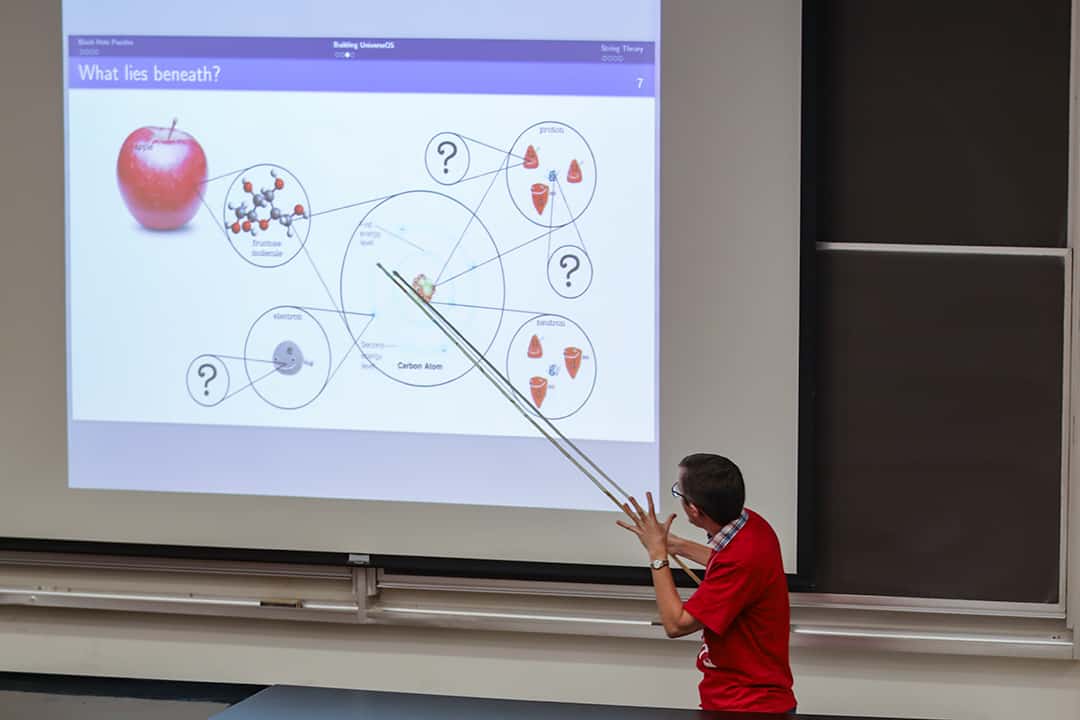From the Department of Physics, Professor A. W. Peet and post-doctoral fellow Aharon Brodutch delivered two related yet different talks about crucial theories of physics to a wide range of attendees of the May 11 Science Rendezvous street festival on the St. George campus.
Gravity causes black holes to exist
Even if you dozed off in high school physics lectures, there’s almost no way you haven’t heard of black holes. Just over a month ago, NASA published the first ever image of a black hole, which left the world in utter awe.
But what causes black holes to exist? To answer, Peet began by explaining the theory of gravity.
We are all familiar with the force of gravity: you drop a tennis ball, and it falls downwards. Gravity is the invisible force that is responsible for the attraction of all objects to each other. Furthermore, the strength of the force is directly related to the object’s mass. The larger the mass, the larger the force of attraction between the objects.
However, gravity not only attracts mass, but it also pulls on light — despite the fact that light is composed of massless particles.
How can gravity ever be strong enough to trap massless light?
Consider black holes: Einstein’s theory of general relativity — which provides an alternative explanation of gravity as a property of space and time — anticipated that when a massive star dies, the remnant it casts off has three times the mass of the Sun, and a black hole is produced.
Peet gave an alternative definition of the phenomenon: “an object is called a black hole if it is dense enough to be contained within its own event horizon.”
The event horizon can be thought of as the point-of-no-return: if you fall into it, escape is impossible, regardless of your rocket power. This also applies to light. Inside this radius, the gravity is so strong that not even light can escape.
Yet despite their attractive force, black holes still emit radiation
Peet mentioned that “at [a black hole’s] heart, there exists a singularity, where its curvature becomes infinite.” With an infinite radius, Einstein’s theory of general relativity fails to demonstrate any results at the singularity of a black hole, since all the equations render infinity as the solution.
Meanwhile, with the employment of quantum theory into Einstein’s theory of general relativity, physicist Stephen Hawking was able to prove that black holes actually do emit radiation — therefore they do not appear completely black after all.
Two theories that cannot exist under the same roof
Einstein’s theory of general relativity describes the physics behind very heavy objects — such as planets, stars, and moons. Quantum mechanics, on the other hand, is the physics relating to extremely small particles.
Now, considering the two, you would think that their incompatibility is not truly problematic, since nothing can be both very heavy and very small. However, when has science ever been that simple?
“There are two things that we care about: black holes and the Big Bang!” added Peet. They continued by saying that in order to be able to effectively and accurately analyze these two mysteries, we would need a theory that could be applied to both massive and small objects.
String theory mends the two clashing theories
String theory predicts that inside the elementary particles — irreducible particles previously thought to be point-like — are actually one-dimensional vibrating strands of energy known as strings. The fact that strings are versatile demonstrates the ease with which they can interact, and thus solves the problems arising from the theory of general relativity.
Peet also mentioned that string theory can predict possible extra dimensions of space, explaining that “the strings could wrap around those hidden dimensions.”
Multiple worlds at once?
Now that we have reached a better understanding of black holes, let us consider other realms and dimensions through our understanding of quantum theory. In 1935, physicist Erwin Schrödinger came up with a world-changing theoretical experiment known as the Schrödinger’s cat paradox.
“He placed a cat in a steel chamber with a Geiger counter, a vial of poison, a hammer, and some radioactive substance,” explained Brodutch.
This process is not one that naturally comes to mind, yet it does make physical sense. With the decay of the radioactive substance, the Geiger counter would prompt the hammer to fall on the vial, releasing the poison and consequently killing the cat. Seems pretty straight forward, right? Then, what is the paradox about?
What Schrödinger wanted to demonstrate, explained Brodutch, was that we would not know whether the cat was dead or alive until we opened the chamber. Thus, in order to be theoretically accurate, we would have to assume that while the steel box is still closed, the cat is both dead and alive simultaneously in two different worlds.
With the help of the Schrödinger’s cat paradox, we are able to somewhat understand the possibility of the existence of more than a single world at once.
The worlds can interfere
This paradox was employed in order to account for the wave function of a particle: the particle could be in any allowed position at a certain instant, yet you could not know exactly where unless you directly saw it.
Brodutch further said that “each world will be one term in the equation, and as the branched worlds keep going, the equation becomes longer and longer.”
Thus, maintaining control over these quantum systems becomes the main concern. Applying quantum theory to modern-day technological advances, Brodutch explained that it enables quantum computers “to factorize really, really fast,” and as a result, “keep [security-sensitive] transactions very secure.”


